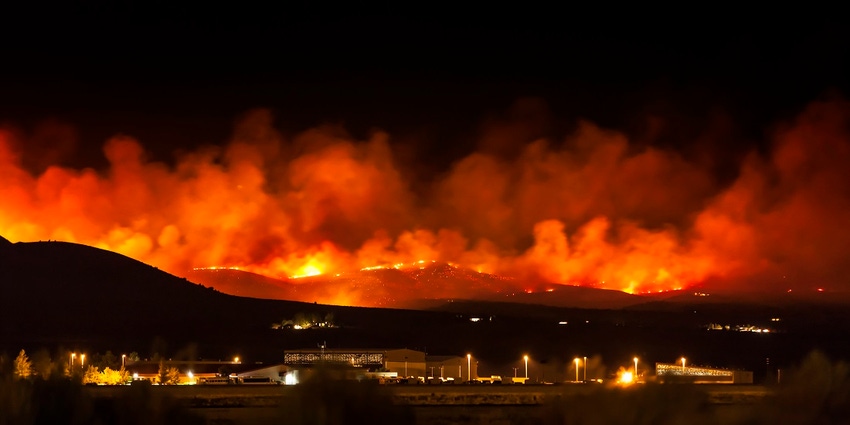Survivors share ideas to survive wildfire
Three Kansas families recall things they learned from wildfire experiences last year and before.

Preparing to avoid wildfire damage is best done ahead of the emergency, for homestead and livestock.
Home preparation is well defined in a number of locations and from several sources. You can read more at this good site, which defines your home's "defensible space" in two stages, totaling a circumference of 100 feet.
Three Kansas ranchers shared their learning from experiences dealing with wildfire in recent years. They share some common recommendations, but rather than try to summarize their experiences or eliminate duplication, the editor chose to let the repetitions stand as extra warning.
Bill Barby of Protection, Kansas, saw his entire B bar B Ranch burn last year in the Starbuck fire. Barby and his wife live in Protection, so their home was not at risk. However, his corrals and some equipment were at risk on the ranch. Working alone and leading cattle with his pickup, Barby managed to save that and all his cattle, which were in two herds. Later he gave us this bulleted list of ideas for preparations:
- Use prescribed burns to give a safe haven to place cattle if wildfire approaches.
- Have a sprayer accessible and a drip torch to back burn if needed for protection.
- Know your escape routes.
- Move cattle, people and equipment Use cool-season annuals such as wheat pasture to.
- Use natural landscape for safe havens like prairie dog towns or where grass is short next to water sources.
- Use rotation or mob grazing to be able to gather herd and move to safety quickly.
- Form a local prescribed burn association (PBA) to help do prescribed burns and help with wildfires. Two neighbors from our local PBA successfully put out the southeast corner of the largest wildfire in Kansas history, the Starbuck wildfire. They also saved both of their homes in doing so. They said their experience with PBA helped them have knowledge of how to put fire out.
Mark Lohrding, also from near Protection, Kansas, lost more than half of his grassland to the Starbuck wildfire last year but no livestock.
After the fact, he wrote to us: "One of the most important things that I did was sit down and write a list of where each group of cattle were and whether they should be moved and if so where to."
Here is his short list of preparations and thoughts.
1. Green wheat and alfalfa fields are your best friends when it comes to a fire know where they’re at and if you can reasonably get to them. Your neighbors will understand if you need to move cattle on to their alfalfa or wheat -- ours did.
2. Human life is most important. Don’t put you or your family at risk.
3. Even no-till operations need a disc that is in usable condition to use to make firebreaks
4. Avoid having lots of fuel next to your home and equipment. Plan to graze short the lots around your homestead and other facilities.
5. Evaluate whether your operation needs a fire vehicle, be it a small truck or trailer or other option. This is not a criticism of the fire department at all: There is a lot of ground out here to cover.
Brian Alexander, who ranches west of Medicine Lodge in Kansas, has seen the ranch he runs with his father, Ted, burned in two wildfires in recent years -- the Anderson Creek fire two years ago and one unnamed fire several years earlier.
Cows in times of stress will respond best to the moving/gathering/calling technique they are most comfortable with. Lots of cattle are trained to respond to a siren (yelp or wail) in this area. That's not ideal, but you rarely hear rural fire department trucks running anything more than lights. Horses and cattle should treat a cut fence just like a gate I would think.
I'm not going to say the Starbuck fire was unique in how fast it moved, but I will say that it rarely happens on this scale, or is as well observed. My theory about the difference in livestock loss between the two is we saw less death in the Anderson Creek wildfire due to more broken (uneven) fuel load. The cattle had more places to hide, plus the fire was moving more slowly.
When you see mass amounts of deer overtaken by fire and dead, there's nothing that could have gotten out of the way.
"Cows with calves are always going to move slowly," he adds. "Beyond that, they will try to run downwind as far and fast as possible, as far as I know. It's my understanding that cattle generally have an awareness of whether they are in mortal peril from fire. I've seen cattle on short grass or wheat pasture just as mellow as could be, grazing while hell rages a couple hundred yards away."
As for saving buildings and homes, he says, "Most of the homes lost that I saw had evidence of nearby cedars; that's the first thing."
Further, he says to evaluate materials used in your home. Such as, do you have asphalt shingles or siding that's flammable? He recommends studying the "defensible space" material mentioned earlier.
"If there's a fire on a red flag day anywhere within 30 miles you should be prepared to activate your last ditch defenses and run. For last ditch defense, I'd say turn on as many sprinklers as you can in your yard, as far upwind as practical, wet down everything else."
About the Author(s)
You May Also Like


.png?width=300&auto=webp&quality=80&disable=upscale)
